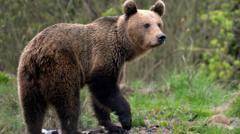A motorcyclist lost his life after being attacked by a bear in Romania's scenic mountains, marking a concerning event in a region increasingly troubled by wildlife encounters.
**Motorcyclist Killed in Bear Attack in Romanian Mountains**

**Motorcyclist Killed in Bear Attack in Romanian Mountains**
A tragic incident highlights the risks of wildlife encounters as a man is killed by a bear in Romania’s picturesque Transfagarasan region.
The man had paused at a popular tourist spot along the Transfagarasan road when a bear dragged him down a steep ravine. Authorities reported that he was already deceased upon their arrival. Ion Sanduloiu, head of the Arges County Mountain Rescue Service, pointed to the severity of the injuries sustained despite the victim wearing protective gear. Local wildlife safety advice emphasizes avoiding feeding bears and maintaining a safe distance.
The attack has sparked investigations, but the bear involved remains unharmed for now. Romania houses the largest brown bear population in the EU, which has led to rising encounters with humans, several of which have turned fatal. Calls for stricter regulations and prevention strategies are being amplified, as genetic studies estimate the brown bear population at approximately 10,400 to 12,800, significantly above sustainable levels suggested by former environment minister Mircea Fechet.
Fechet advocates for regulatory changes allowing local authorities to act swiftly against bears encroaching residential areas, including euthanasia if necessary. He also proposes the introduction of risk zone maps to manage bear populations effectively, balancing wildlife preservation with human safety. Conversely, conservationists like Gabriel Paun assert that the real issue is mismanagement rather than overpopulation.
He criticized insufficient measures by local authorities and the government to foster safer cohabitation between humans and wildlife, asserting that climate change, habitat loss, and illegal hunting also pose significant threats to bear populations. Sanduloiu echoed the need for more stringent deterrents, suggesting hefty fines or imprisonment for those who risk their safety by feeding bears.
As discussions continue about wildlife management and safety, the tragic death serves as a sobering reminder of the complexities involved in human-wildlife interactions.
The attack has sparked investigations, but the bear involved remains unharmed for now. Romania houses the largest brown bear population in the EU, which has led to rising encounters with humans, several of which have turned fatal. Calls for stricter regulations and prevention strategies are being amplified, as genetic studies estimate the brown bear population at approximately 10,400 to 12,800, significantly above sustainable levels suggested by former environment minister Mircea Fechet.
Fechet advocates for regulatory changes allowing local authorities to act swiftly against bears encroaching residential areas, including euthanasia if necessary. He also proposes the introduction of risk zone maps to manage bear populations effectively, balancing wildlife preservation with human safety. Conversely, conservationists like Gabriel Paun assert that the real issue is mismanagement rather than overpopulation.
He criticized insufficient measures by local authorities and the government to foster safer cohabitation between humans and wildlife, asserting that climate change, habitat loss, and illegal hunting also pose significant threats to bear populations. Sanduloiu echoed the need for more stringent deterrents, suggesting hefty fines or imprisonment for those who risk their safety by feeding bears.
As discussions continue about wildlife management and safety, the tragic death serves as a sobering reminder of the complexities involved in human-wildlife interactions.

















